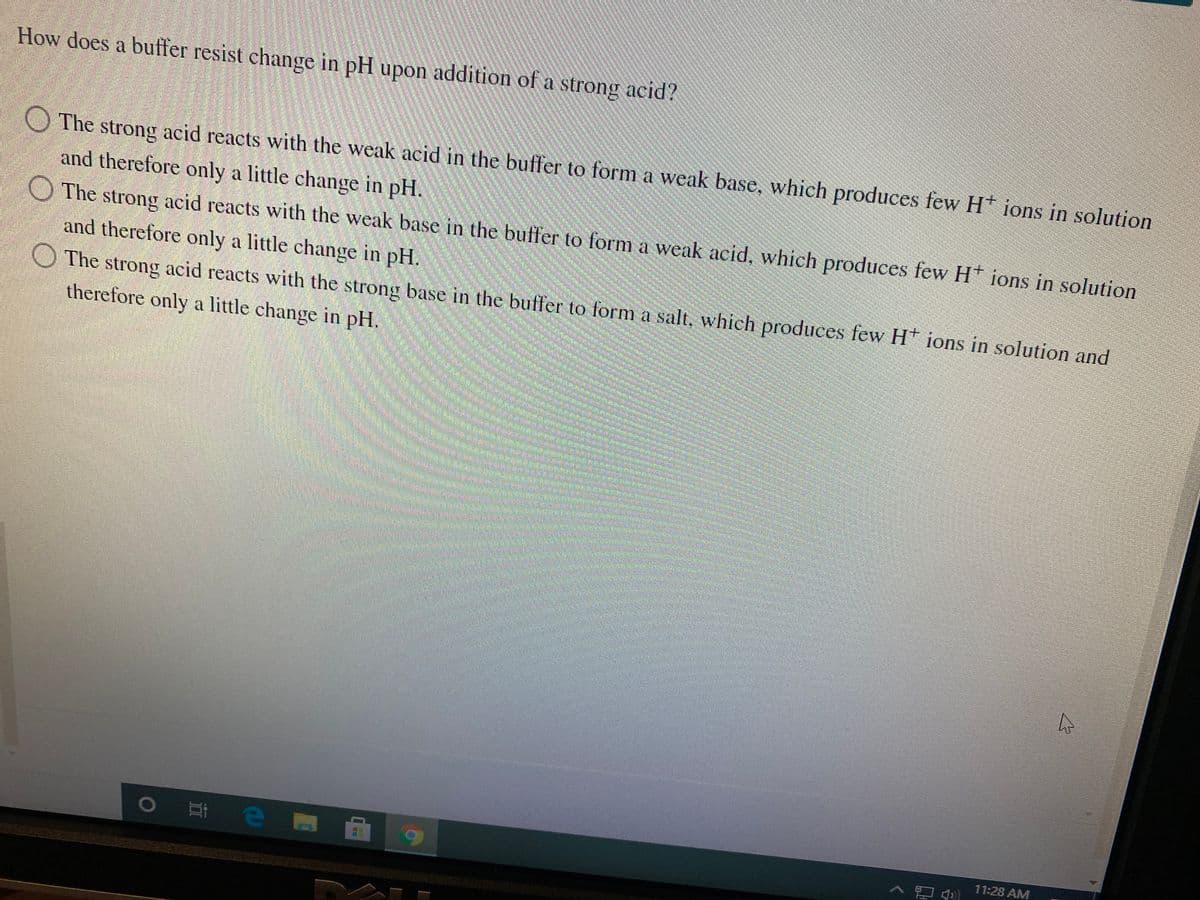How does a buffer resist change in pH upon addition of a strong acid? O The strong acid reacts with the weak acid in the buffer to form a weak base, which produces few H* ions in solution and therefore only a little change in pH. O The strong acid reacts with the weak base in the buffer to form a weak acid, which produces few H* ions in solution and therefore only a little change in pH. O The strong acid reacts with the strong base in the buffer to form a salt, which produces few Ht ions in solution and therefore only a little change in pH.
How does a buffer resist change in pH upon addition of a strong acid? O The strong acid reacts with the weak acid in the buffer to form a weak base, which produces few H* ions in solution and therefore only a little change in pH. O The strong acid reacts with the weak base in the buffer to form a weak acid, which produces few H* ions in solution and therefore only a little change in pH. O The strong acid reacts with the strong base in the buffer to form a salt, which produces few Ht ions in solution and therefore only a little change in pH.
Chemistry: The Molecular Science
5th Edition
ISBN:9781285199047
Author:John W. Moore, Conrad L. Stanitski
Publisher:John W. Moore, Conrad L. Stanitski
Chapter15: Additional Aqueous Equilibria
Section: Chapter Questions
Problem 85QRT: A buffer solution was prepared by adding 4.95 g sodium acetate to 250. mL of 0.150-M acetic...
Related questions
Question

Transcribed Image Text:How does a buffer resist change in pH upon addition of a strong acid?
The strong acid reacts with the weak acid in the buffer to form a weak base, which produces few H* ions in solution
and therefore only a little change in pH.
O The strong acid reacts with the weak base in the buffer to form a weak acid, which produces few H* ions in solution
and therefore only a little change in pH.
O The strong acid reacts with the strong base in the buffer to form a salt, which produces few H* ions in solution and
therefore only a little change in pH.
) 耳e
11:28 AM
Expert Solution
This question has been solved!
Explore an expertly crafted, step-by-step solution for a thorough understanding of key concepts.
This is a popular solution!
Trending now
This is a popular solution!
Step by step
Solved in 2 steps with 2 images

Knowledge Booster
Learn more about
Need a deep-dive on the concept behind this application? Look no further. Learn more about this topic, chemistry and related others by exploring similar questions and additional content below.Recommended textbooks for you

Chemistry: The Molecular Science
Chemistry
ISBN:
9781285199047
Author:
John W. Moore, Conrad L. Stanitski
Publisher:
Cengage Learning

Chemistry & Chemical Reactivity
Chemistry
ISBN:
9781337399074
Author:
John C. Kotz, Paul M. Treichel, John Townsend, David Treichel
Publisher:
Cengage Learning

Chemistry & Chemical Reactivity
Chemistry
ISBN:
9781133949640
Author:
John C. Kotz, Paul M. Treichel, John Townsend, David Treichel
Publisher:
Cengage Learning

Chemistry: The Molecular Science
Chemistry
ISBN:
9781285199047
Author:
John W. Moore, Conrad L. Stanitski
Publisher:
Cengage Learning

Chemistry & Chemical Reactivity
Chemistry
ISBN:
9781337399074
Author:
John C. Kotz, Paul M. Treichel, John Townsend, David Treichel
Publisher:
Cengage Learning

Chemistry & Chemical Reactivity
Chemistry
ISBN:
9781133949640
Author:
John C. Kotz, Paul M. Treichel, John Townsend, David Treichel
Publisher:
Cengage Learning

Chemistry: Principles and Reactions
Chemistry
ISBN:
9781305079373
Author:
William L. Masterton, Cecile N. Hurley
Publisher:
Cengage Learning

Chemistry: An Atoms First Approach
Chemistry
ISBN:
9781305079243
Author:
Steven S. Zumdahl, Susan A. Zumdahl
Publisher:
Cengage Learning

Chemistry: Principles and Practice
Chemistry
ISBN:
9780534420123
Author:
Daniel L. Reger, Scott R. Goode, David W. Ball, Edward Mercer
Publisher:
Cengage Learning